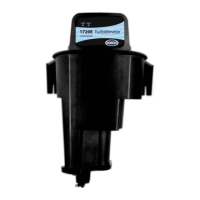Installation
15
Figure 13 Using the Optional Strain Relief and Conduit Plug
Figure 14 Proper Wire Preparation and Insertion
3.2.3 Wiring for Power at the Controller
Wire the instrument for line power by hard-wiring in conduit or by wiring to a power
cord if local code allows. Regardless of the type of wire used, the connections are
made at the same terminal. A local disconnect designed to meet local electrical
code is required and must be identified for all types of installation. See Figure 16
and Figure 17 on page 17 for suggested local disconnect configurations.
1. Obtain appropriate fittings with NEMA 4X/IP66 environmental rating.
2. Loosen the screws using a phillips-head screwdriver and open the hinged
controller cover.
3. Remove the high-voltage barrier (see Figure 12 on page 14).
4. Insert the wires through the strain relief fitting or conduit hub located in the
right-rear access hole in the bottom of the enclosure. Tighten the strain relief if
used, to secure the cord.
5. Properly prepare each wire (Figure 14) and insert each wire into the terminal
according to Table 4. Tug gently after each insertion to ensure the connection
is secure.
6. Seal any unused openings in the controller box with conduit opening sealing
plugs, see Replacement Parts and Accessories on page 55.
7. Reinstall the high-voltage barrier and latch to secure.
1. Power cord strain relief 2. Conduit strain relief 3. Conduit opening sealing plug
1. Strip ¼-inch of insulation. 2. Seat insulation against connector with no bare wire exposed.
2
3
1
2

